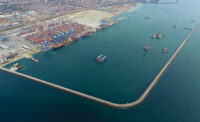When the 2,000-ton cutterhead of a tunnel-boring machine named Harriet made a U-turn last summer in Miami, the event marked a major turning point for the Port of Miami tunnel project.
After Harriet broke through the end of one 4,200-ft-long, 42.3-ft-dia tunnel under Biscayne Bay last July, crews with the design-build team, led by Bouygues Civil Works Florida, used a giant Teflon turntable to rotate the TBM's cutterhead and shield in preparation for boring a twin tunnel in the opposite direction.
The feat is one of many milestones and firsts for the $663-million construction portion of the $1-billion project, now more than halfway complete. When done, the tunnels will provide new access to Miami's port and ease congestion in the region.
Complex geology and a congested urban setting continue to challenge the design-build team as it constructs cross passages and completes tunneling through eight different layers of earth using both the earth-pressure-balance method (EPBM) and water-controlled pressure, also called hydraulic mucking.
"This is the first time that a large-diameter tunnel has been bored through coralline limestone," says Louis P. Brais, project executive with Bouygues, whose French parent company has an equity stake in the public-private partnership (P3) financing. The limestone—found in the seventh layer, approximately 80 ft to 110 ft deep—is extremely porous and unstable.
The concrete for the tunnel, which, when completed, will allow some 16,000 daily trucks to bypass local streets and directly access PortMiami from Interstate 395 and I-95, is expected to last 150 years. It is the first tunnel in the U.S. with a passive fire protection system: concrete panels specially treated for fireproofing, says Trevor Jackson, chief executive officer with MAT Concessionaire LLC. MAT will maintain the untolled tunnel and receive performance-based availability payments—as much as $32.5 million annually—until it hands the operations back to the Florida Dept. of Transportation in October 2044.
Meanwhile, the concessionaire stands to earn as much as $450 million for completing five construction milestones, with the final one to come in August 2014 upon final acceptance, says Mark Croft, Florida Dept. of Transportation construction program manager.
Mystery Layer
Wedged between Miami's downtown and the famous Miami Beach area, the project squeezes in between the MacArthur Causeway and two man-made islands, Dodge Island and Watson Island, which also serve as its portals. Before beginning the east-bound launch from Watson Island, the design-build team embarked, in 2010, on an extensive supplementary geotechnical investigation that lasted 22 months, says Bouygues' geotechnical director, Roger B. Storry.
"It was difficult for us to get samples of this [seventh] layer," Storry says, referring to the worrisome coralline limestone. The investigation was so extensive, "there was a hole approximately every 32 feet," he says. "It took that much to understand the nature of this layer." The team performed a variety of tests, including ultrasonic, cone penetration, rock coring, permeability and water flow, and camera log surveys. In addition, crews sank five 8-ft-dia shafts to the lowest point of the tunnels, at 120 ft.
The team not only investigated all the permutations of the eight layers at various locations in its on-site lab but also sent to European labs the soil samples, Biscayne Bay seawater and the grout mix it developed, says Storry.
Nicholson Construction Co. won the approximately $40-million contract in 2011 to fill voids in the seventh layer with the bentonite-rich, weak-strength grout, says Storry. "The grout is like a toothpaste—thick, to prevent it from flowing away," he adds. At Watson Island and on a flotilla of barges that had to work around the schedules of ships entering the port, crews drilled 1,000 holes as deep as 120 ft and injected 65,000 cu yards of grout to stabilize the layer.









